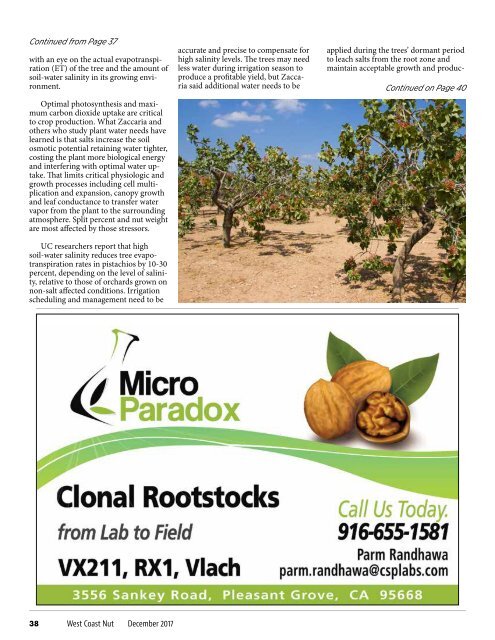WCN_Dec17WEB
You also want an ePaper? Increase the reach of your titles
YUMPU automatically turns print PDFs into web optimized ePapers that Google loves.
Continued from Page 37<br />
with an eye on the actual evapotranspiration<br />
(ET) of the tree and the amount of<br />
soil-water salinity in its growing environment.<br />
Optimal photosynthesis and maximum<br />
carbon dioxide uptake are critical<br />
to crop production. What Zaccaria and<br />
others who study plant water needs have<br />
learned is that salts increase the soil<br />
osmotic potential retaining water tighter,<br />
costing the plant more biological energy<br />
and interfering with optimal water uptake.<br />
That limits critical physiologic and<br />
growth processes including cell multiplication<br />
and expansion, canopy growth<br />
and leaf conductance to transfer water<br />
vapor from the plant to the surrounding<br />
atmosphere. Split percent and nut weight<br />
are most affected by those stressors.<br />
UC researchers report that high<br />
soil-water salinity reduces tree evapotranspiration<br />
rates in pistachios by 10-30<br />
percent, depending on the level of salinity,<br />
relative to those of orchards grown on<br />
non-salt affected conditions. Irrigation<br />
scheduling and management need to be<br />
accurate and precise to compensate for<br />
high salinity levels. The trees may need<br />
less water during irrigation season to<br />
produce a profitable yield, but Zaccaria<br />
said additional water needs to be<br />
applied during the trees’ dormant period<br />
to leach salts from the root zone and<br />
maintain acceptable growth and produc-<br />
Continued on Page 40<br />
38 West Coast Nut December 2017


















